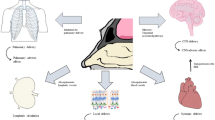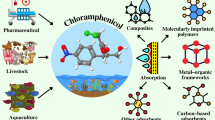Abstract
Purpose
The aim of this work was to develop clarithromycin microparticles (CLARI-MP) and evaluate their aerodynamic behavior, safety in bronchial cells and anti-bacterial efficacy.
Methods
Microparticles containing clarithromycin were prepared as dry powder carrier for inhalation, using leucine and chitosan. CLARI-MP were deposited on Calu-3 grown at air-interface condition, using the pharmaceutical aerosol deposition device on cell cultures (PADDOCC). Deposition efficacy, transport across the cells and cytotoxicity were determined. Anti-antibacterial effect was evaluated against Pseudomonas aeruginosa, Escherichia coli and Staphylococcus aureus.
Results
Microparticles were of spherical shape, smooth surface and size of about 765 nm. Aerosolization performance showed a fine particle fraction (FPF) of 73.3%, and a mass median aerodynamic diameter (MMAD) of 1.8 μm. Deposition on Calu-3 cells using the PADDOCC showed that 8.7 μg/cm2 of deposited powder were transported to the basolateral compartment after 24 h. The safety of this formulation is supported by the integrity of the cellular epithelial barrier and absence of toxicity, and the antimicrobial activity demonstrated for Gram positive and Gram negative bacteria.
Conclusions
The appropriate aerodynamic properties and the excellent deposition on Calu-3 cells indicate that clarithromycin microparticles are suitable for administration via pulmonary route and are efficient to inhibit bacteria proliferation.






Similar content being viewed by others
Abbreviations
- Blank-MP:
-
Blank microparticles
- CLARI:
-
Clarithromycin
- CLARI-MP:
-
Clarithromycin microparticles
- DPI:
-
Dry powder inhalers
- DSC:
-
Differential scanning calorimetry
- ED:
-
Emitted dose
- FPF:
-
Fine particle fraction
- IS:
-
Internal standard
- LC-MS/MS:
-
Liquid chromatography - tandem mass spectrometry
- MIC:
-
Minimal inhibitory concentration
- MMAD:
-
Mass median aerodynamic diameter
- NGI:
-
Next-generation pharmaceutical impactor
- PADDOCC:
-
Pharmaceutical aerosol deposition device on cell cultures
- PM:
-
Physical mixture
- RI:
-
Respiratory infection
- SEM:
-
Scanning electron microscopy
- TEER:
-
Transepithelial electrical resistance
References
Cipolla D, Chan H-K. Inhaled antibiotics to treat lung infection. Pharm Pat Anal. 2013;2(5):647–63.
Park C-W, Li X, Vogt FG, Hayes Jr D, Zwischenberger JB, Park E-S, et al. Advanced spray-dried design, physicochemical characterization, and aerosol dispersion performance of vancomycin and clarithromycin multifunctional controlled release particles for targeted respiratory delivery as dry powder inhalation aerosols. Int J Pharm. 2013;455(1–2):374–92.
John SP, Peter RB. Inhaling medicines: delivering drugs to the body through the lungs. Nat Rev Drug Discov. 2007;6(1):67–74.
Saadat A, Zhu B, Haghi M, King G, Colombo G, Young PM, et al. The formulation, chemical and physical characterisation of clarithromycin-based macrolide solution pressurised metered dose inhaler. J Pharm Pharmacol. 2014;66(5):639–45.
Haghi M, Saadat A, Zhu B, Colombo G, King G, Young PM, Traini D. Immunomodulatory effects of a low-dose clarithromycin-based macrolide solution pressurised metered dose inhaler. Pharm Res. 2014:1–10.
Pilcer G, Rosiere R, Traina K, Sebti T, Vanderbist F, Amighi K. New co-spray-dried tobramycin nanoparticles-clarithromycin inhaled powder systems for lung infection therapy in cystic fibrosis patients. J Pharm Sci. 2013;102(6):1836–46.
Roa WH, Azarmi S, Al-Hallak MHDK, Finlay WH, Magliocco AM, Löbenberg R. Inhalable nanoparticles, a non-invasive approach to treat lung cancer in a mouse model. J Control Release. 2011;150(1):49–55.
Adi H, Young PM, Chan H-K, Stewart P, Agus H, Traini D. Cospray dried antibiotics for dry powder lung delivery. J Pharm Sci. 2008;97(8):3356–66.
Nandiyanto ABD, Okuyama K. Progress in developing spray-drying methods for the production of controlled morphology particles: from the nanometer to submicrometer size ranges. Adv Powder Technol. 2011;22(1):1–19.
Dimer FA, Durli TL, Fontana MC, Pohlmann AR, Beck RCR, Guterres SS. Piezoelectric atomizing spray-dryer to convert liquids to dry powders: operational parameters and formulation characteristics. In: Tran HT, Pillai G, editors. Advances in nanotechnology & applications - volume IV: CreateSpace Independent Publishing Platform; 2012. p. 105–16.
Hein S, Bur M, Schaefer UF, Lehr C-M. A new Pharmaceutical Aerosol Deposition Device on Cell Cultures (PADDOCC) to evaluate pulmonary drug absorption for metered dose dry powder formulations. Eur J Pharm Biopharm. 2011;77(1):132–8.
de Bruijne K, Ebersviller S, Sexton KG, Lake S, Leith D, Goodman R, et al. Design and testing of Electrostatic Aerosol in vitro Exposure System (EAVES): an alternative exposure system for particles. Inhal Toxicol. 2009;21(2):91–101.
Bur M, Rothen-Rutishauser B, Huwer H, Lehr C-M. A novel cell compatible impingement system to study in vitro drug absorption from dry powder aerosol formulations. Eur J Pharm Biopharm. 2009;72(2):350–7.
Haghi M, Traini D, Young P. In vitro cell integrated impactor deposition methodology for the study of aerodynamically relevant size fractions from commercial pressurised metered dose inhalers. Pharm Res. 2014;31(7):1779–87.
Haghi M, Traini D, Bebawy M, Young PM. Deposition, diffusion and transport mechanism of dry powder microparticulate salbutamol, at the respiratory epithelia. Mol Pharm. 2012;9(6):1717–26.
Hoppentocht M, Hagedoorn P, Frijlink HW, de Boer AH. Technological and practical challenges of dry powder inhalers and formulations. Adv Drug Deliv Rev. 2014;75:18–31.
Zarogoulidis P, Kioumis I, Ritzoulis C, Petridis D, Darwiche K, Porpodis K, et al. New insights in the production of aerosol antibiotics. Evaluation of the optimal aerosol production system for ampicillin-sulbactam, meropenem, ceftazidime, cefepime and piperacillin-tazobactam. Int J Pharm. 2013;455(1–2):182–8.
Trapnell BC, McColley SA, Kissner DG, Rolfe MW, Rosen JM, McKevitt M, et al. Fosfomycin/tobramycin for inhalation in patients with cystic fibrosis with pseudomonas airway infection. Am J Respir Crit Care Med. 2012;185(2):171–8.
David SR, Bergstrom RF, Bruner VL, Mitchell MI. Pharmacokinetics and pharmacodynamics of IM olanzapine. Schizophr Res. 2002;53(3):183.
Zuckerman JM, Qamar F, Bono BR. Review of macrolides (Azithromycin, Clarithromycin), Ketolids (Telithromycin) and Glycylcyclines (Tigecycline). Med Clin N Am. 2011;95(4):761–91.
Bermudez LE, Nash K, Petrofsky M, Young LS, Inderlied CB. Clarithromycin-resistant mycobacterium avium is still susceptible to treatment with clarithromycin and is virulent in mice. Antimicrob Agents Chemother. 2000;44(10):2619–22.
Global Alliance for TB Drug Development. Clarithromycin. Tuberculosis. 2008;88(2):92–5.
Moghaddam PH, Ramezani V, Esfandi E, Vatanara A, Nabi-Meibodi M, Darabi M, et al. Development of a nano–micro carrier system for sustained pulmonary delivery of clarithromycin. Powder Technol. 2013;239:478–83.
Shin J, Pauly DF, Johnson JA, Frye RF. Simplified method for determination of clarithromycin in human plasma using protein precipitation in a 96-well format and liquid chromatography-tandem mass spectrometry. J Chromatogr B. 2008;871(1):130–4.
Podczeck F. Comparison of in vitro dissolution profiles by calculating mean dissolution time (MDT) or mean residence time (MRT). Int J Pharm. 1993;97(1–3):93–100.
Haghi M, Young PM, Traini D, Jaiswal R, Gong J, Bebawy M. Time- and passage-dependent characteristics of a Calu-3 respiratory epithelial cell model. Drug Dev Ind Pharm. 2010;36(10):1207–14.
Hein S, Bur M, Kolb T, Muellinger B, Schaefer UF, Lehr CM. The Pharmaceutical Aerosol Deposition Device on Cell Cultures (PADDOCC) in vitro system: design and experimental protocol. Altern Lab Anim. 2010;38(4):285–95.
Sahner JH, Groh M, Negri M, Haupenthal J, Hartmann RW. Novel small molecule inhibitors targeting the “switch region” of bacterial RNAP: structure-based optimization of a virtual screening hit. Eur J Med Chem. 2013;65:223–31.
Hoe S, Ivey J, Boraey M, Shamsaddini-Shahrbabak A, Javaheri E, Matinkhoo S, et al. Use of a fundamental approach to spray-drying formulation design to facilitate the development of multi-component dry powder aerosols for respiratory drug delivery. Pharm Res. 2014;31(2):449–65.
Grenha A, Al-Qadi S, Seijo B, Remuñán-López C. The potential of chitosan for pulmonary drug delivery. J Drug Delivery Sci Technol. 2010;20(1):33–43.
Chu BY, Kobiasi MA, Zeng W, Mainwaring D, Jackson DC. Chitosan-based particles as biocompatible delivery vehicles for peptide and protein-based vaccines. Procedia Vaccinol. 2012;6:74–9.
Lee C, Choi JS, Kim I, Oh KT, Lee ES, Park E-S, et al. Long-acting inhalable chitosan-coated poly(lactic-co-glycolic acid) nanoparticles containing hydrophobically modified exendin-4 for treating type 2 diabetes. Int J Nanomedicine. 2013;8:2975–83.
Kean T, Thanou M. Biodegradation, biodistribution and toxicity of chitosan. Adv Drug Del Rev. 2010;62(1):3–11.
Okamoto H, Shiraki K, Yasuda R, Danjo K, Watanabe Y. Chitosan–interferon-β gene complex powder for inhalation treatment of lung metastasis in mice. J Control Release. 2011;150(2):187–95.
Sogias IA, Williams AC, Khutoryanskiy VV. Why is Chitosan Mucoadhesive? Biomacromolecules. 2008;9(7):1837–42.
Dhawan S, Singla AK, Sinha VR. Evaluation of mucoadhesive properties of chitosan microspheres prepared by different methods. AAPS PharmSciTech. 2004;5(4):122–8.
Feng AL, Boraey MA, Gwin MA, Finlay PR, Kuehl PJ, Vehring R. Mechanistic models facilitate efficient development of leucine containing microparticles for pulmonary drug delivery. Int J Pharm. 2011;409(1–2):156–63.
Aquino RP, Prota L, Auriemma G, Santoro A, Mencherini T, Colombo G, et al. Dry powder inhalers of gentamicin and leucine: formulation parameters, aerosol performance and in vitro toxicity on CuFi1 cells. Int J Pharm. 2012;426(1–2):100–7.
Dharmadhikari AS, Kabadi M, Gerety B, Hickey AJ, Fourie PB, Nardell E. Phase I, single-dose, dose-escalating study of inhaled dry powder capreomycin: a new approach to therapy of drug-resistant tuberculosis. Antimicrob Agents Chemother. 2013;57(6):2613–9.
Mohammadi G, Nokhodchi A, Barzegar-Jalali M, Lotfipour F, Adibkia K, Ehyaei N, et al. Physicochemical and anti-bacterial performance characterization of clarithromycin nanoparticles as colloidal drug delivery system. Colloids Surf B. 2011;88(1):39–44.
Valizadeh H, Mohammadi G, Ehyaei R, Milani M, Azhdarzadeh M, Zakeri-Milani P, et al. Antibacterial activity of clarithromycin loaded PLGA nanoparticles. Pharmazie. 2012;67(1):63–8.
Schmid K, Arpagaus C, Friess W. Evaluation of the Nano Spray Dryer B-90 for pharmaceutical applications. Pharm Dev Technol. 2011;16(4):287–94.
Durli TL, Dimer FA, Fontana MC, Pohlmann AR, Beck RC, Guterres SS. Innovative approach to produce submicron drug particles by vibrational atomization spray drying: influence of the type of solvent and surfactant. Drug Dev Ind Pharm. 2013.
Gomez-Burgaz M, Torrado G, Torrado S. Characterization and superficial transformations on mini-matrices made of interpolymer complexes of chitosan and carboxymethylcellulose during in vitro clarithromycin release. Eur J Pharm Biopharm. 2009;73(1):130–9.
Chiu MH, Prenner EJ. Differential scanning calorimetry: an invaluable tool for a detailed thermodynamic characterization of macromolecules and their interactions. J Pharm Bioall Sci. 2011;3(1):39–59.
Riley T, Christopher D, Arp J, Casazza A, Colombani A, Cooper A, et al. Challenges with developing in vitro dissolution tests for orally inhaled products (OIPs). AAPS PharmSciTech. 2012;13(3):978–89.
Beck-Broichsitter M, Schweiger C, Schmehl T, Gessler T, Seeger W, Kissel T. Characterization of novel spray-dried polymeric particles for controlled pulmonary drug delivery. J Control Release. 2012;158(2):329–35.
Lee SH, Teo J, Heng D, Zhao Y, Ng WK, Chan HK, et al. Steroid-decorated antibiotic microparticles for inhaled anti-infective therapy. J Pharm Sci. 2014;103(4):1115–25.
Belotti S, Rossi A, Colombo P, Bettini R, Rekkas D, Politis S, et al. Spray dried amikacin powder for inhalation in cystic fibrosis patients: a quality by design approach for product construction. Int J Pharm. 2014;471(1–2):507–15.
Grainger CI, Greenwell LL, Lockley DJ, Martin GP, Forbes B. Culture of Calu-3 cells at the air interface provides a representative model of the airway epithelial barrier. Pharm Res. 2006;23(7):1482–90.
ACKNOWLEDGMENTS AND DISCLOSURES
Frantiescoli Dimer is thankful to the Brazilian Coordenação de Aperfeiçoamento de Pessoal de Nível Superior (CAPES) program “Ciência sem Fronteiras” project number BEX 18215/12-2. The authors kindly thank Simone Amann for bacteria experiments, Marius Hittinger for NGI and PADDOCC experiments and Dr. Chiara Rossi for technical support of LC-MS/MS and SEM analysis.
Author information
Authors and Affiliations
Corresponding author
Electronic supplementary material
Below is the link to the electronic supplementary material.
Fig S1
Scanning electron micrograph of Clarithromycin raw material. (JPEG 416 kb)
Fig S2
Bacteria growth after 18 h of treatment with microparticles without clarithromycin (BLANK-MP), clarithromycin solution (CLARI) and clarithromycin microparticles (CLARI-MP) compared to CONTROL against P. aeruginosa (A), E. coli (B) and S. aureus (C). The percentage was calculated from final experiment optical density subtracted from initial optical density compared to CONTROL. The data show 3 independent experiments (means ± SD). * Different from CONTROL: p < 0.05; ** Different from CONTROL: p < 0.01; *** Different from CONTROL: p < 0.001; ### Different from CLARI: p < 0.001. (JPEG 325 kb)
Rights and permissions
About this article
Cite this article
Dimer, F., de Souza Carvalho-Wodarz, C., Haupenthal, J. et al. Inhalable Clarithromycin Microparticles for Treatment of Respiratory Infections. Pharm Res 32, 3850–3861 (2015). https://doi.org/10.1007/s11095-015-1745-8
Received:
Accepted:
Published:
Issue Date:
DOI: https://doi.org/10.1007/s11095-015-1745-8




